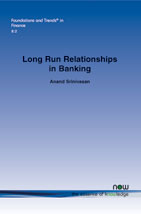Long Run Relationships in Banking
By Anand Srinivasan, Department of Finance, NUS Business School, National University of Singapore, Singapore, bizas@nus.edu.sg
Abstract
This monograph surveys the effects of long-run relationships in banking between corporate borrowers and lenders. The first part of the survey analyzes econometric issues in the measurement of the costs and benefits of such relationships. In particular, we analyze potential issues with commonly used proxies of relationship lending — duration, scope and intensity. This analysis, as well as studies that have access to internal bank records, suggest that intensity (fraction of the total lending of a borrower by a given bank) would be a better measure of relationship lending, relative to duration. This analysis also suggests that accounting for endogeneity of relationships and simultaneity of loan contract terms does not qualitatively impact the results of earlier literature. Papers with the ability to circumvent several of the econometric issues are discussed in detail. The second part of this monograph is similar to a standard review where papers relating to hold-up costs, multiple banking relationships, impact of competition on relationship banking, and measurement of soft information in banking are covered.
Long Run Relationships in Banking
Long Run Relationships in Banking analyzes the effects of long run relationships in banking between corporate borrowers and lenders. The first part of the monograph starts by briefly reviewing theory on bank relationships. While the second part is focused on statistical issues in quantifying the effects of relationship banking, and analyzing various empirical biases that are likely to arise when using common proxies for relationship banking. The author also analyzes the impact of competition on relationships, and reviews the evidence on direct importance of soft information in lending providing a validation of the continued specialness of banks.
Long Run Relationships in Banking is organized as follows. Section 2 briefly reviews the theoretical arguments for the prevalence of long run relationships in banking. Section 3 reviews evidence on the ways in which relationships add value. Section 4 critiques existing empirical approaches used to measure relationship banking effects, focusing on the validity of the commonly used empirical proxies to capture the underlying economic constructs of relationship banking. Section 5 surveys the burgeoning literature on hold up (switching costs) of borrowers by banks that circumvent some of the empirical issues raised above. Section 6 examines the motivations for firms to engage in multiple banking relationships that are not related to circumscribing the rents arising from hold up. Section 7 examines the impact of competition on relationship banking. Theory and empirical evidence suggests a complex relationship between the two. Section 8 reviews more direct evidence on the importance of soft information in relationship banking, and Section 9 concludes with directions for future research.
